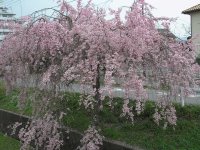 Yesterday the weather was clear and my wife was still on term break this week, so we took local trains through small towns and sometimes scenic countryside from Ashikaga to Oyama to Mito to visit the nationally famous Kairakuen (偕楽園 'shared pleasure park'), one of Japan's three most beautiful landscape gardens. As the name implies, the park is open to the public; and the views are indeed spectacular. The blossoms on the 3,000 plum trees for which the park is most famous may have been a few weeks past their prime, but the cherry blossoms were in full bloom (満開, compare 満タン 'full tank [of gas]) both in the park and across the broad expanse of Senba (千波 'thousand wave') Lake and Park, which the Kairakuen hillside overlooks. Here are two verbal souvenirs from the trip.
Yesterday the weather was clear and my wife was still on term break this week, so we took local trains through small towns and sometimes scenic countryside from Ashikaga to Oyama to Mito to visit the nationally famous Kairakuen (偕楽園 'shared pleasure park'), one of Japan's three most beautiful landscape gardens. As the name implies, the park is open to the public; and the views are indeed spectacular. The blossoms on the 3,000 plum trees for which the park is most famous may have been a few weeks past their prime, but the cherry blossoms were in full bloom (満開, compare 満タン 'full tank [of gas]) both in the park and across the broad expanse of Senba (千波 'thousand wave') Lake and Park, which the Kairakuen hillside overlooks. Here are two verbal souvenirs from the trip.Bokeh – This is an English technical term borrowed from Japanese, as I learned from Philbert Ono's PhotoWords. The Photoxels Glossary of Digital Photography Terms defines it thus:
Boke (pronounced BOH-KEH), and increasingly referred to in print as "Bokeh" - Japanese word meaning "fuzzy" and referring to the out-of-focus (OOF) portions of a picture. A lens is said to have "good boke" if the OOF is pleasant and does not detract from the main subject. A lens with good boke produces out of focus smooth-edged highlights and reproduces an out of focus point of light as bright in the middle and progressively getting fainter with a fuzzy edge.I'm not sure which Japanese boke this English borrowing comes from. Certainly not 木瓜 'Japanese quince, japonica', which I was excited to find in full bloom, glistening like coral on the garden path down to Senba Lake. My best guess is 惚け/呆け, whose several meanings include 'dull, dullheadedness', as in 呆け色 boke iro 'dull color', from a verb 惚け/呆け meaning 'grow senile; become mentally weak; fade, discolor'. The New Nelson kanji dictionary and Kenkyusha's New Japanese–English Intermediate Dictionary, 5th ed. (in my Canon Wordtank), are not quite in synch on this, and neither of them mentions usage in photography. In any case, both my digital photographs and my digital words here are sure to provide plenty of evidence of boke.
Oddly enough, while English has borrowed a Japanese word for the out-of-focus part of a photo, Japanese appears to have borrowed a Dutch word for the in-focus spot: Japanese ピント pinto, from Dutch punt van focus or (focus)punt. (Dutch u is a front-rounded vowel—front like Italian i, round like Italian u—while Dutch oe renders the equivalent of English oo.)
枝垂れ桜 shidare-zakura 'branch-drooping cherry tree', Prunus pendula – Among the few types of cherry trees I can now reliably recognize are the branch-drooping ones. I'm also pretty good on 枝垂れ柳 shidare-yanagi 'branch-drooping willow'. Yes, yes, I know that most people characterize both types as 'weeping', but that bit of poetic license completely bypasses the etymological briar patch that this prosaic pedant intends to poke his nose into.
Leaving out the tree itself, there are two pieces to the attribute 枝垂れ: 枝 shi 'branch', whose Japanese reading is eda, as in edamame '(soy)beans on the branch (or at least in their pods)'; and 垂れ tare 'drippings, sauce, gravy, jus'. When it relates to apparel, 垂れ can also mean 'hanging, curtain, lapel, flap, skirts of a coat'. So 垂れ tare covers the range of 'drip, drop, droop, drape' (which helped inspire one English linguist to coin the term phonaesthesia).
The Sino-Japanese phonetic element 支 shi of the two-part kanji 枝 itself means 'branch' in a lot of compounds, such as 支社 shisha 'branch (company) office'; 支流 shiryuu 'branch (flow), tributary'; 支族 shizoku 'branch family, tribe'. To be more specific, one can rely on the semantic element 木 ki 'tree', which often relates to wood (either woody plants or items once made of wood), to disambiguate the 枝 shi that specifically means 'tree branch'. Another contrast relies on the semantic element 肉 'meat' (= 月 in combination), which usually relates to the body, so 肢 shi indicates 'limbs of the body, arms and legs'.
Finally, 支 (in the shape of 枝) shi can be completely redundant. The New Nelson gives shidareru as an alternate reading for simple 垂れる tareru (vi and vt) 'hang, droop, drop, lower, pull down; dangle; sag; drip, ooze, trickle', so it's perfectly okay to say 柳の枝が枝垂れている yanagi no eda ga shidareteiru 'the branches of the willow are (branch-)drooping'. Webster's Online Dictionary offers more—much more—on the semantics of droop in a wide range of languages. Turkish and Romanian are particularly rich.
No comments:
Post a Comment